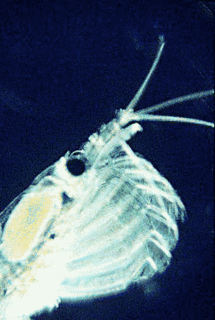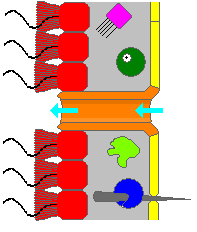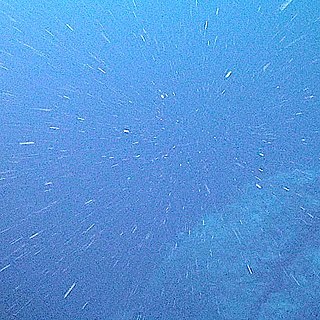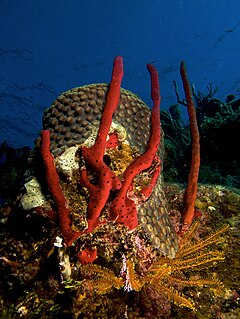
Sponges, the members of the phylum Porifera, are a basal Metazoa (animal) clade as a sister of the Diploblasts. They are multicellular organisms that have bodies full of pores and channels allowing water to circulate through them, consisting of jelly-like mesohyl sandwiched between two thin layers of cells. The branch of zoology that studies sponges is known as spongiology.

Zooplankton are heterotrophic plankton. Plankton are organisms drifting in oceans, seas, and bodies of fresh water. The word zooplankton is derived from the Greek zoon (ζῴον), meaning "animal", and planktos (πλαγκτός), meaning "wanderer" or "drifter". Individual zooplankton are usually microscopic, but some are larger and visible to the naked eye.

The biological pump, also known as the marine carbon pump, is, in its simplest form, the ocean's biologically driven sequestration of carbon from the atmosphere and land runoff to the ocean interior and seafloor sediments. It is the part of the oceanic carbon cycle responsible for the cycling of organic matter formed mainly by phytoplankton during photosynthesis (soft-tissue pump), as well as the cycling of calcium carbonate (CaCO3) formed into shells by certain organisms such as plankton and mollusks (carbonate pump).

Filter feeders are a sub-group of suspension feeding animals that feed by straining suspended matter and food particles from water, typically by passing the water over a specialized filtering structure. Some animals that use this method of feeding are clams, krill, sponges, baleen whales, and many fish. Some birds, such as flamingos and certain species of duck, are also filter feeders. Filter feeders can play an important role in clarifying water, and are therefore considered ecosystem engineers. They are also important in bioaccumulation and, as a result, as indicator organisms.

Choanocytes are cells that line the interior of asconoid, syconoid and leuconoid body types of sponges that contain a central flagellum, or cilium, surrounded by a collar of microvilli which are connected by a thin membrane. They make up the choanoderm, a type of cell layer found in sponges. The cell has the closest resemblance to the choanoflagellates which are the closest related single celled protists to the animal kingdom (metazoans). The flagellae beat regularly, creating a water flow across the microvilli which can then filter nutrients from the water taken from the collar of the sponge. Food particles are then phagocytosed by the cell.

Agelas clathrodes, also known as the orange elephant ear sponge, is a species of sea sponge. It lives on reefs in the Caribbean, usually more than 10 metres (33 ft) below the surface of the ocean. It takes various forms, and its color is reddish orange.

In the deep ocean, marine snow is a continuous shower of mostly organic detritus falling from the upper layers of the water column. It is a significant means of exporting energy from the light-rich photic zone to the aphotic zone below, which is referred to as the biological pump. Export production is the amount of organic matter produced in the ocean by primary production that is not recycled (remineralised) before it sinks into the aphotic zone. Because of the role of export production in the ocean's biological pump, it is typically measured in units of carbon .The term was first coined by the explorer William Beebe as he observed it from his bathysphere. As the origin of marine snow lies in activities within the productive photic zone, the prevalence of marine snow changes with seasonal fluctuations in photosynthetic activity and ocean currents. Marine snow can be an important food source for organisms living in the aphotic zone, particularly for organisms which live very deep in the water column.
Brenna Hufford, Brianna Baysek, Kindsay Goldburg

Amphimedon compressa, the erect rope sponge, red tree sponge, red tubular sponge, or red sponge is a demosponge found in southern Florida, the Caribbean Sea, and the Bahamas. It can be deep red, orange, brown, or black.

Ianthella basta, commonly known as elephant ear sponge, is a species of fan-shaped sea sponge in the class Demospongiae. It is also known as the paper sponge or scroll sponge.

Sycon ciliatum is a species of calcareous sponge belonging to the family Sycettidae.

Sycon raphanus is a species of marine invertebrate, a calcareous sponge belonging to the family Sycettidae. The name derives from the Greek, "raphanus", meaning radish, and presumably refers to the sponge's shape.
Homaxinella balfourensis is a species of sea sponge in the family Suberitidae. It is found in the seas around Antarctica and can grow in two forms, either branching out in one plane like a fan or forming an upright club-like structure.

Tectitethya crypta is a species of demosponge belonging to the family Tethyidae. Its classified family is characterized by fourteen different known genera, one of them being Tectitethya. It is a massive, shallow-water sponge found in the Caribbean Sea. This sponge was first discovered by Werner Bergmann in 1945 and later classified by de Laubenfels in 1949. It is located in reef areas situated on softer substrates such as sand or mud. Oftentimes, it is covered in sand and algae. This results in an appearance that is cream colored/ gray colored; however, when the animal is washed free of its sediment coverings, its body plan appears more green and gray. It's characterized with ostia peaking out of its body cavity, with the ability to abruptly open or close, changing its desired water flow rate through its mesohyl.
Agelas schmidti, commonly known as the brown tubular sponge, is a species of demosponge. It occurs at moderate depths in the Gulf of Mexico and the Caribbean Sea and often has a colonial coral growing over the surface. The type locality is Puerto Rico.
Neofibularia nolitangere, commonly known as the touch-me-not sponge, is a species of sea sponge in the family Biemnidae. It is found in shallow waters in the Western Atlantic Ocean and the Caribbean Sea.

Haliclona cearulea is a species of marine sponge in the family Chalinidae. It is an encrusting tubular sponge that grows anchored on rocky surfaces of coral reefs.

The viral shunt is a mechanism that prevents marine microbial particulate organic matter (POM) from migrating up trophic levels by recycling them into dissolved organic matter (DOM), which can be readily taken up by microorganisms. The DOM recycled by the viral shunt pathway is comparable to the amount generated by the other main sources of marine DOM.
Corticium candelabrum is a species of sponge in the order Homosclerophorida. It is native to the eastern Atlantic Ocean and the Mediterranean Sea where it inhabits the shallow sublittoral zone. The type locality is the Adriatic Sea.
Halisarcidae is a family of sea sponges within the order Chondrillida. Members of the family are characterised by having long tubular, branched choanocyte chambers; they have no spicules which makes it difficult to determine the group's affinities with other sponge families. Halisarcidae is a monogeneric family, the only genus being Halisarca.













